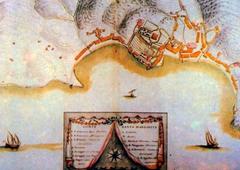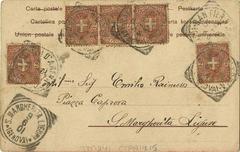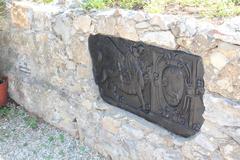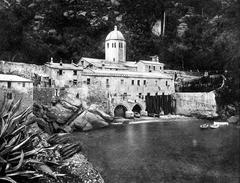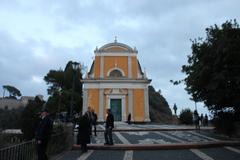
Comprehensive Guide to Visiting Santa Margherita Ligure and Rapallo in Italy
Publication Date: 17/08/2024
Introduction to Santa Margherita Ligure and Rapallo
Nestled along the stunning Ligurian coast of Italy, Santa Margherita Ligure and Rapallo are towns renowned for their rich history, cultural heritage, and scenic beauty. These towns are not just popular tourist destinations but also repositories of a vibrant past that dates back to Roman times. From the early periods of Roman influence and medieval turmoil to the transformative eras of Genoese rule and Napoleonic unification, Santa Margherita Ligure and Rapallo have witnessed significant historical events that have shaped their unique character. (Wikipedia, Britannica)
Santa Margherita Ligure, often referred to as the ‘Pearl of Tigullio,’ stands out for its strategic location on the Gulf of Tigullio. This prime positioning made it an essential maritime hub, especially during the Middle Ages when it evolved from a simple fishing village into a fortified town. The Genoese Senate’s construction of the Santa Margherita Castle in the 16th century to protect against pirate attacks is a testament to this transformation. Today, the town is a bustling tourist destination known for its historical landmarks, picturesque harbor, and vibrant cultural scene. (Nomads Travel Guide)
Similarly, Rapallo boasts a rich historical tapestry, from its Roman origins to its significant role in the medieval and Renaissance periods. The town’s notable landmarks, such as the 16th-century Castle of Rapallo and the Sanctuary of Our Lady of Montallegro, draw thousands of visitors each year. The 20th century added another layer to Rapallo’s historical significance, as it became the site of pivotal diplomatic treaties during the World Wars. Today, Rapallo is celebrated for its mild climate, elegant hotels, and scenic promenades, making it a favorite among tourists and history enthusiasts alike. (Britannica, Italy of All)
This comprehensive guide aims to provide you with a detailed overview of what to see and do in Santa Margherita Ligure and Rapallo. From historical sites and local cuisine to travel tips and visitor information, this guide will help you make the most of your visit to these enchanting Ligurian towns.
Contents Overview
- Introduction
- Santa Margherita Ligure
- Early History and Roman Influence
- Medieval Turmoil and Feudal Era
- Genoese Rule and Pirate Attacks
- Napoleonic Era and Unification of Italy
- Modern Development and Tourism
- Visitor Information
- Rapallo
- Early History and Medieval Period
- Renaissance and Baroque Periods
- 20th Century and Treaty Signings
- Modern Era and Tourism
- Visitor Information
- Key Historical Landmarks
- Santa Margherita Ligure
- Rapallo
- FAQ
- Conclusion
Discover the Rich History and Visitor Information of Santa Margherita Ligure and Rapallo, Liguria
Santa Margherita Ligure
Early History and Roman Influence
Santa Margherita Ligure, located in the Metropolitan City of Genoa in the Liguria region, has a history that is somewhat shrouded in mystery. While the presence of a Roman settlement has not been definitively proven, the area was known to be inhabited during Roman times (Wikipedia). The town, originally known as Pescino, faced significant turmoil during the early medieval period.
Medieval Turmoil and Feudal Era
In 641, the Lombards under King Rothari devastated Pescino, marking the beginning of a series of invasions and occupations. The Saracens followed in the 10th century, further contributing to the town’s instability (Lecinqueterre). By the 11th century, the area came under the influence of the Abbey of San Colombano di Bobbio and later became a fiefdom of the Fieschi family of Lavagna.
Genoese Rule and Pirate Attacks
In 1229, Santa Margherita Ligure was incorporated into the Republic of Genoa, a significant shift that brought relative stability and growth. However, the town was not immune to external threats. In 1432, it was attacked by the Venetian fleet, and in 1549, the infamous Turkish pirate Dragut sacked the town along with nearby Rapallo (Wikipedia).
Napoleonic Era and Unification of Italy
The Napoleonic era brought further changes. In 1813, under Napoleonic rule, the two burghs of Pescino and Corte were unified as Porto Napoleone. This unification was short-lived, as the town was annexed to the Kingdom of Sardinia in 1815 and renamed Santa Margherita Ligure. By 1861, it became part of the newly unified Kingdom of Italy (Wikipedia).
Modern Development and Tourism
The 20th century saw significant development in Santa Margherita Ligure, particularly after World War II. The town was connected by rail, facilitating its transformation into a renowned tourist resort. The post-war era, especially the 1960s, marked a period of unprecedented tourism growth, establishing Santa Margherita Ligure as a vibrant and bustling town, particularly during the summer months (Nomads Travel Guide).
Visitor Information
- Visiting Hours: Most historical sites are open from 9 AM to 6 PM, but it’s advisable to check specific timings on official websites.
- Tickets: Entry fees vary; the 16th-Century Castle usually charges around €5, while the Basilica di Santa Margherita is free to enter.
- Travel Tips: For a smooth experience, consider visiting during weekdays to avoid crowds.
- Nearby Attractions: Don’t miss the picturesque harbor and the charming town center.
Rapallo
Early History and Medieval Period
Rapallo, located in the province of Genoa, Liguria, has a rich history dating back to Roman times. The town was first mentioned in historical records in 964. Like Santa Margherita Ligure, Rapallo faced numerous invasions, including those by the Lombards, Normans, and Swiss (Britannica).
Renaissance and Baroque Periods
The Renaissance and Baroque periods were significant for Rapallo. The town’s most notable historical site, the Castle of Rapallo, dates back to the 16th century. This period also saw the construction of the Sanctuary of Our Lady of Montallegro in 1557, a significant religious site that continues to attract pilgrims and tourists alike (Italy of All).
20th Century and Treaty Signings
The 20th century was a pivotal time for Rapallo. It was the site of the Allied Conference of Rapallo in 1917 during World War I. The town also hosted the signing of two significant treaties: the Treaty of Rapallo between Italy and Yugoslavia in 1920 and the Treaty of Rapallo between Germany and the Soviet Union in 1922. These treaties established friendly relations and had far-reaching geopolitical implications (Britannica).
Modern Era and Tourism
Rapallo became a city in 1956 and has since developed into a thriving resort known for its mild climate and fine hotels. The town’s economy is primarily driven by tourism, although it also has industries producing pillow lace, olive oil, textiles, cement, and special steels (Britannica). The town’s scenic beauty, with its palm-lined promenades, colorful buildings, and picturesque harbor, makes it a popular destination for tourists seeking both relaxation and historical exploration (Italy This Way).
Visitor Information
- Visiting Hours: Historical sites generally open from 9 AM to 7 PM, with the Sanctuary of Our Lady of Montallegro having specific hours for pilgrimages.
- Tickets: Entry fees range from €3 for the Castle of Rapallo to free entry for the Sanctuary.
- Travel Tips: Use the local cable car for breathtaking views of the town and coastline.
- Nearby Attractions: Explore the nearby Portofino Natural Park for outdoor activities.
Key Historical Landmarks
Santa Margherita Ligure
- 16th-Century Castle: This historical structure offers a glimpse into the town’s past and its strategic importance.
- 17th-Century Basilica di Santa Margherita: A significant religious site that showcases the town’s architectural and cultural heritage (Savoring Italy).
Rapallo
- Castle of Rapallo: Dating back to the 16th century, this castle is a testament to the town’s historical significance and strategic importance.
- Sanctuary of Our Lady of Montallegro: Built in 1557, this sanctuary is a major pilgrimage site and offers stunning views of the surrounding area (Italy of All).
FAQ
Q: What are the visiting hours for Santa Margherita Ligure’s historical sites? A: Most sites are open from 9 AM to 6 PM, but checking specific timings online is recommended.
Q: Are there any entry fees for Rapallo’s landmarks? A: Entry fees vary; the Castle of Rapallo charges around €3, while the Sanctuary of Our Lady of Montallegro is free.
Q: What are some travel tips for visiting these towns? A: Visit during weekdays to avoid crowds, and consider using local transportation options like the cable car in Rapallo for scenic views.
Q: Are there any special events or guided tours available? A: Yes, both towns offer guided tours and host special events throughout the year. Check local tourism websites for the latest information.
Conclusion
The historical backgrounds of Santa Margherita Ligure and Rapallo are rich and varied, reflecting the broader historical currents of the Ligurian coast. From ancient invasions to modern tourism, these towns offer a fascinating glimpse into the past while providing a vibrant and appealing destination for contemporary visitors. Plan your visit to explore these historical sites and experience the cultural richness of Liguria. For more updates and travel guides, follow us on social media or download our mobile app Audiala.
